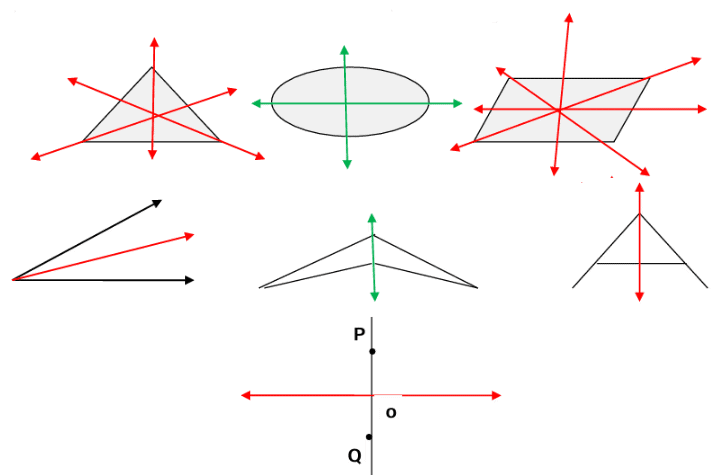Class 6 Exam > Class 6 Notes > Maths Olympiad Class 6 > Revision Notes: Symmetry - Including Constructions
Revision Notes: Symmetry - Including Constructions | Maths Olympiad Class 6 PDF Download
Linear Symmetry
Symmetry
A plane figure is said to have symmetry (or linear symmetry) if on folding the figure about a line on it, the two parts of figures exactly coincide.
The line about which the figure is symmetrical is called "line of symmetry" or "an axis of symmetry" or simply a "mirror line"
Line segments shows the line of symmetry for given polygons

Symmetric point: In the figure above point P on the line, when folded along the line of syymetry co insides with Q. Hence Q is said to be "symmetric point".
To locate symmetric point of point P:
(i) Draw a perpendicular line OP from point P to the line of symmetry
(ii) Extend PO and cut OQ = OP
The document Revision Notes: Symmetry - Including Constructions | Maths Olympiad Class 6 is a part of the Class 6 Course Maths Olympiad Class 6.
All you need of Class 6 at this link: Class 6
|
30 videos|120 docs|59 tests
|
FAQs on Revision Notes: Symmetry - Including Constructions - Maths Olympiad Class 6
| 1. What is linear symmetry in geometry? |  |
Ans.Linear symmetry, also known as reflection symmetry, occurs when a shape can be divided into two identical halves that are mirror images of each other. If you draw a line through the shape (the line of symmetry), both sides will look the same.
| 2. How can I identify lines of symmetry in different shapes? |  |
Ans.To identify lines of symmetry, you can fold the shape along different lines. If the two halves match perfectly when folded, that line is a line of symmetry. For example, a square has four lines of symmetry, while a circle has infinite lines of symmetry.
| 3. Can you explain the process of constructing symmetrical shapes? |  |
Ans.To construct symmetrical shapes, start by drawing the line of symmetry. Then, use a ruler or compass to measure equal distances from the line to create points on both sides. Connect these points to form the shape, ensuring both halves are identical.
| 4. What are some examples of linear symmetry in everyday life? |  |
Ans.Examples of linear symmetry in everyday life include butterfly wings, human faces, and many logos. Nature often displays symmetry, such as in flowers and leaves, where one side mirrors the other.
| 5. Why is understanding symmetry important in mathematics and art? |  |
Ans.Understanding symmetry is crucial in mathematics for solving problems related to shapes and patterns. In art, symmetry contributes to aesthetics, balance, and harmony in designs, making artworks visually appealing and organized.
Related Searches















